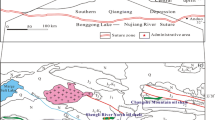Abstract—The average concentrations of trace elements, including toxic elements, in shales from various shale basins of the world are reported. The concentrations of a number of elements significantly exceeding the Clarke numbers for clay rocks in the Kenderlyk shale of the Republic of Kazakhstan, in the Domanic sediments of the Volga–Ural oil and gas bearing basin, some American formations (Barnett), etc., were noted. It was demonstrated that the concentrations of potentially toxic elements in many deposits were higher than their average values in clays and other sedimentary rocks. The release of potentially toxic elements into the environment significantly increased as a result of thermal effects on the formation, which can occur on the development of similar deposits of fossil fuels and in some hydrocarbon conversion processes. This was confirmed by natural observations and laboratory studies. On the hydraulic fracturing, which is widely used in the development of shale formations by the horizontal drilling method, toxic elements from both shales and their naphthide components can be released into the environment. In the development of shale deposits, additional studies are required for the monitoring of the trace element composition of shale formations to exclude environmental risks.




Similar content being viewed by others
REFERENCES
Dvenadtsatova, T.I., Neft’, Gaz, Pravo, 2015, no. 6, p. 36.
Johnson, R.C., Birdwell, J.E., Mercier, T.J., and Brownfield, M.E., Scientific Investigations Report: Geological Survey, Reston, 2016.
Nemec, R., Pipeline . Gas J., 2016, no. 11, p. 56.
Shpirt, M.Ya. and Punanova, S.A., Neft. Khoz., 2017, no. 4, p. 58.
Safronov, A.F., Mater. Vseros. Nauch.-prakt. konf. “Chernye slantsy: geologiya, litologiya, geokhimiya, znachenie dlya neftegazovogo kompleksa, perspektivy ispol’zovaniya kak al’ternativnogo uglevodorodnogo syr’ya” (Proc. All-Russia Sci.-Pract. Conf. “Black Shale: Geology, Lithology, Geochemistry, Importance for the Oil–Gas Complex, and Prospects for Use as an Alternative Hydrocarbon Raw Material”), Yakutsk: Akhsaan, 2015, p. 63.
Gol’dberg, I.S., Mitskevich, A.A., and Lebedeva, G.V., Problemy otsenki resursov i kompleksnogo osvoeniya prirodnykh bitumov, vysokovyazkikh neftei i soputstvuyushchim im metallov (Problems of Resource Assessment and Integrated Development of Natural Bitumen, High-Viscosity Oils, and Related Metals), Leningrad: VNIGRI, 1990, p. 49.
Tissot, B. and Welte, D., Petroleum Formation and Occurrence, Heidelberg: Springer, 1978.
Vinogradov, A.P., Geokhimiya, 1956, no. 1, p. 6.
Ketris, M.P. and Yudovich, Ya.E., Int. J. Coal Geol., 2009, vol. 78, no. 2, p. Ð. 135.
Kler, V.R., Nenakhova, F.Ya., Saprykin, F.Ya., and Shpirt, M.Ya., Metallogeniya i geokhimiya uglenosnykh i slantsesoderzhashchikh tolshch SSSR. Zakonomernosti kontsentratsii elementov i metody ikh izucheniya (Metallogeny and Geochemistry of Coal-Bearing and Shale-Bearing Strata of the USSR: Regularities of Concentration of Elements and Methods of Their Study), Moscow: Nauka, 1988.
Shpirt, M.Ya. and Punanova, S.A., Microelements of caustobioliths: Problems of Genesis and Industrial Use, Saarbrucken, Lambert Academic, 2012.
Punanova, S.A. and Nukenov, D., Georesursy, 2017, vol. 19, no. 3, p. 148.
Zanin, Yu.N., Zamirailova, A.G., and Eder, V.G., Mater. Vseros. Nauch.-prakt. konf. “Chernye slantsy: geologiya, litologiya, geokhimiya, znachenie dlya neftegazovogo kompleksa, perspektivy ispol’zovaniya kak al’ternativnogo uglevodorodnogo syr’ya” (Proc. All-Russia Sci.-Pract. Conf. “Black Shale: Geology, Lithology, Geochemistry, Importance for the Oil–Gas Complex, and Prospects for Use as an Alternative Hydrocarbon Raw Material”), Yakutsk: Akhsaan, 2015, p. 128.
Zueva I.N., Chalaya O.N., Kashirtsev V.A., Glyaznetsova Yu.S. Kalinin A.I., Mater. Vseros. Nauch.-prakt. konf. “Chernye slantsy: geologiya, litologiya, geokhimiya, znachenie dlya neftegazovogo kompleksa, perspektivy ispol’zovaniya kak al’ternativnogo uglevodorodnogo syr’ya” (Proc. All-Russia Sci.-Pract. Conf. “Black Shale: Geology, Lithology, Geochemistry, Importance for the Oil–Gas Complex, and Prospects for Use as an Alternative Hydrocarbon Raw Material”), Yakutsk: Akhsaan, 2015, p. 133.
Zueva, I.N., Chalaya, O.N., Lifshits, S.Kh., and Glyaznetsova, Yu.S., Mater. VI VNPK “Geologiya i Mineral’no-syr’evye resursy Severo-Vostoka Rossii” (Proc. VI Conf. “Geology and Mineral Resources of the North-East of Russia”), Yakutsk: SVFU, 216, p. 346.
Chizoba, C.N., Chemostratigraphy of the Mississipian-Age Barnett Formation, Fort Worth Basin, Wise County, Univ. of Texas at Arlington, 2013.
Bai, J., Wang, Q., Li, Ch., Guan, X., Li, S., and Sun, B., Abstracts of Papers, Int. Conf. on Power Engineering-2007, Hangzhou (China), 2007, p. 185.
Yakutseni, S.P., Rasprostranennost’ uglevodorodov, obogashchennykh tyazhelymi elementami-primesyami. Otsenka ekologicheskikh riskov (The Abundance of Hydrocarbons Enriched with Heavy Element Impurities: Assessment of Environmental Risks), St. Petersburg: Nedra, 2005.
Abramova, O.P. and Abukova, L.A., Mater. Vseros. Nauch.-prakt. konf. “Chernye slantsy: geologiya, litologiya, geokhimiya, znachenie dlya neftegazovogo kompleksa, perspektivy ispol’zovaniya kak al’ternativnogo uglevodorodnogo syr’ya” (Proc. All-Russia Sci.-Pract. Conf. “Black Shale: Geology, Lithology, Geochemistry, Importance for the Oil–Gas Complex, and Prospects for Use as an Alternative Hydrocarbon Raw Material”), Yakutsk: Akhsaan, 2015, p. 9.
Yakutseni, S.P., Neftegaz. Geol. Teoriya Prakt., 2010, vol. 5, no. 2. http://www.ngtp.ru.
Punanova, S.A., Lositskaya, I.F., Semenova, R.A., and Chakhmakhchev, V.A., Geokhimiya, 1988, no. 9, p. 1360.
Wilhelm, S.M., Liang, L., Cussen, D., and Kirchgessner, D.A., Environ. Sci. Technol., 2007, vol. 41, no. 13, p. 4509.
Kelly, W.R., Long, S.E., and Mann, J.L., Anal. Bioanal. Chem., 2003, no. 376, p. 753.
Shpirt, M.Ya. and Punanova, S.A., Solid Fuel Chem., 2011, no. 5, p. 330.
Wilhelm, S.M., Environ. Sci. Technol., 2001, vol. 35, no. 24, p. 4704.
Shpirt, M.Ya. and Punanova, S.A., Mat. Mezhdunar. konf. “Resursovosproizvodyashchie, malootkhodnye i prirodookhrannye tekhnologii osvoeniya nedr” (Resource Reproduction, Low-Waste and Environmentally Friendly Technologies for the Development of Mineral Resources), Bishkek, 2015, p. 158.
Shpirt, M.Ya. and Punanova, S.A., Abstracts of Papers, 27th Int. Meeting on Organic Geochemistry (IMOG 2015), Prague, 2015, p. 504.
Author information
Authors and Affiliations
Corresponding authors
Additional information
Translated by V. Makhlyarchuk
About this article
Cite this article
Punanova, S.A., Shpirt, M.Y. Ecological Consequences of the Development of Shale Formations Containing Toxic Elements. Solid Fuel Chem. 52, 396–405 (2018). https://doi.org/10.3103/S0361521918060095
Received:
Published:
Issue Date:
DOI: https://doi.org/10.3103/S0361521918060095




